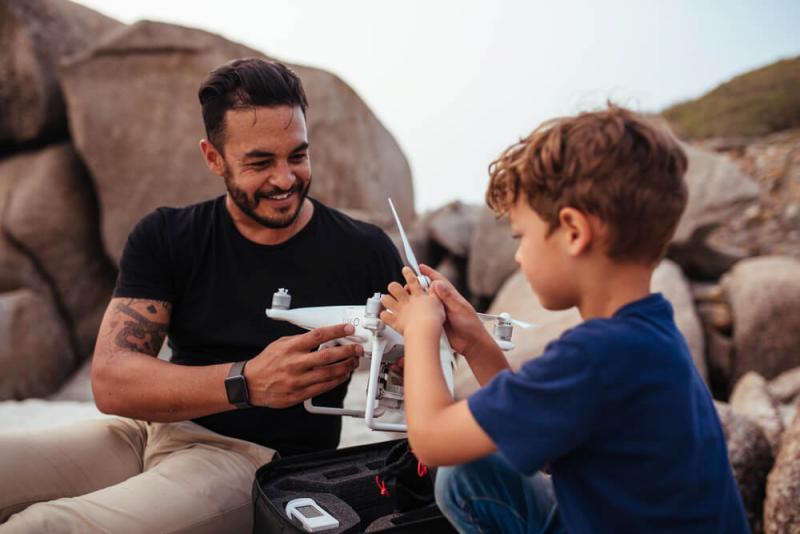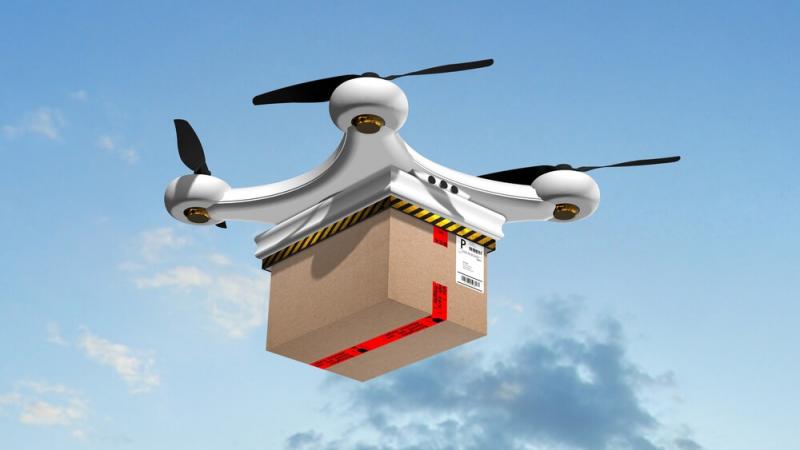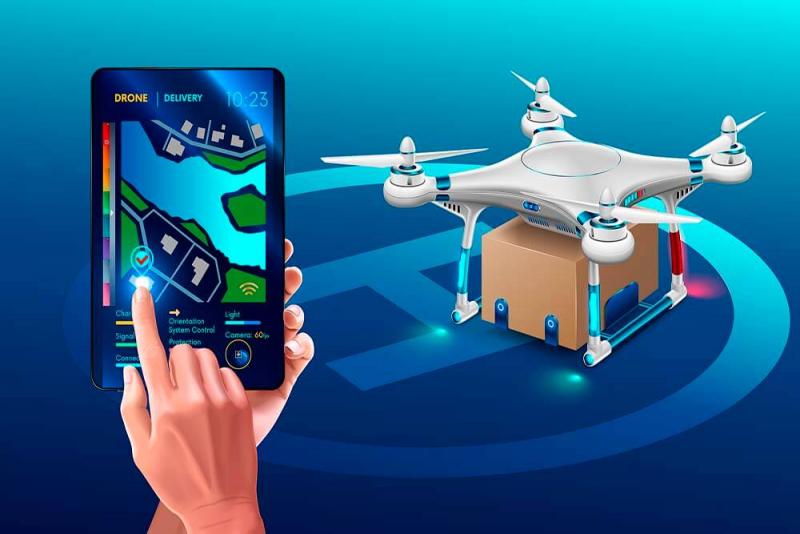Dr. Mostafa Hassanalian, one of the distinguished IUT Alumni and currently an assistant professor in the Department of Mechanical Engineering at New Mexico Tech, has recently achieved the New Mexico Tech Student Government Association outstanding Faculty Member Award for 2019-2020.
Dr. Hassanalian completed his BSc and first MSc degrees from Isfahan University of Technology in 2013 and earned his PhD and second MSc in Mechanical Engineering from New Mexico State University. He has been researching on different types of drones (UAV/MAV/NAV/PAV) for 10 years. Flapping wing micro and nano air vehicles, tilt-rotor and tilt-wing drones, Morphing drones, space and marine drones, separation and swarming flight of micro drones, flight dynamics, biomimetics, fluid-structure interaction, and optimization are his main research interests. Dr.Hassanalian and his team are currently studying various aspects of drones and Smart Cities.
The website SaverDrone.com published a listicle titled "5 Ways COVID-19 is Making Drone Delivery the New Normal." The posting includes a short explanation of NMT professor Dr.Mostafa Hassanalian's research related to how drones could function future "Smart Cities".

Hassanalian has published numerous papers about his drone research.Here is an excerpt and a link to the website:
 5 Ways COVID-19 is Making Drone Delivery the New Normal:
5 Ways COVID-19 is Making Drone Delivery the New Normal:
.The coronavirus pandemic has brought on an increased use of drones in both public health and private business sectors
Thanks to shifting consumer attitude toward drones, the demand for contactless deliveries, and the need for an adaptive supply chain, delivery drones are taking the front stage as a solution across industries. Let’s look at five reasons drone deliveries will soon be a new normal in America:
1. Improving Public Opinion of Drones
The recent development of autonomous drones seems to have come just in time to help facilitate social distancing during a pandemic. Industries like the mining and oil industries have been using autonomous drones since before the coronavirus outbreak, and Amazon has had its Prime Air drone delivery system in the works for a while now. Still, most Americans haven’t had any experience with delivery drones. To some, it’s something out of a sci-fi movie or a distant future.
The global pandemic has been changing the public’s attitude about drones. The delivery of personal protective equipment (PPE) to essential workers needing it has demonstrated the critical role drones can play in protecting public safety.
Given the lockdowns and quarantines, drones have proven to be the best form of contactless delivery, which slows the spread of the virus to reduce the burden on hospitals. Most consumers would opt to rely on drones if it helps them react appropriately to a public health crisis while maintaining their quality of life. Now that delivery drones have been shown to make health measures quicker and more effective, they’re positioned to become a norm more readily accepted for applications across industries.
As concerns mount over the economy’s recovery from COVID-19, small business owners can also see the economic value in using drones for delivery and automation. This is another cause for shift in public opinion.

2. Automating Deliveries Cuts Overhead Costs
Autonomous drones are lightweight but can lift heavy FedEx packages and safely land large grocery orders. Cargo drones have already been developed and are ready to go for commercial use. Due to regulatory obstacles, they aren’t in play at large scale. Small businesses that lost revenue because of COVID-19 could benefit from transitioning to a drone delivery system if local regulators allow it, because the system would drastically reduce supply chain costs.
According to one estimate, drone delivery costs 70% less than van delivery. In Amazon’s model, switching to Prime Air would save the company 80% compared to premium ground shipping via UPS or FedEx. The clearing of regulatory hindrances has been underway for some time, and companies preparing for a drone switch now in advance will be positioned for a more competitive edge in the near future.

3. Optimizing the Supply Chain for Agility
Given the economic uncertainty ahead, investing in drone delivery is a smart resilience strategy for businesses. Besides optimizing the supply chain for cost-effectiveness, a drone delivery system also optimizes for agility, which is of ever-growing importance for a globalized economy, as COVID-19 has been demonstrating.
A deli in Indianapolis started deploying delivery drones in response to the COVID-19 lockdown. This small example took place within just a 3-mile radius, but it’s an indication of the value drones can provide in terms of securing small business continuity.
Early in May, CVS and UPS partnered with the drone company Matternet and leveraged their M2 drone system to deliver prescription medicines to 135,000 quarantined. By partnering with a drone company, it had the agility required to supply demand under unexpected circumstances. In the road ahead, companies across industries will benefit from creating strategic partnerships with drone companies, or from developing an in-house drone delivery system—Amazon’s Prime Air being the largest example.

4. Spurring Faster Innovation in Drone Safety
Different drones operate in different ways, with technologies like GPS, follow-me function and flight path programming. One of the major safety concerns preventing drones from being widely adopted for commercial use is the requirement of having an operator to navigate around anomalies and variables like birds, other drones and high-speed winds.
In a paper published in the 2020 2020 AIAA SciTech Conference , Javad Shahmoradi and other researchers from New Mexico Tech under the supervision of Dr. Mostafa Hassanalian from Mechanical Engineering and Dr. Pedram Roghanchi from Mineral Engineering Departments tested a spherical drone that would enhance safety and reliability. The flexible structure and material of these drones are made to enable them to avoid hardware damage and overcome obstacles in confined spaces people cannot access.
Now that contactless delivery has become more important, overcoming safety issues to pass regulatory hurdles is a technological imperative. Drones with advanced sensors and cameras for discerning objects in their flight path have been used in mines. Research suggests if they can safely automate the transportation of materials in confined spaces that have low visibility, they could be designed to navigate to homes safely and autonomously, too.
5. Fueling the Development of Smart City Technology
The adoption of smart city technology has never been at the top of municipal agendas, but its potential for reducing carbon emissions is well known. A transition to smart cities is even more advantageous for governments in a global pandemic. Just like smart cars would rely on smart traffic lights to navigate, delivery drones would also require smart city technology to operate safely. Without roads and traffic lights floating in the air for drones to follow, they need infrastructure that keeps the entire environment safe.
In another study out of New Mexico Tech supervised by Dr. Mostafa Hassanalian, Amir Mirzaeinia, a Ph.D. student of Computer Science modeled a drone delivery scenario at scale. Taking inspiration from bird nests, the researchers developed hyper-localized stations (nests) from which drones can take off, land and charge. Instead of returning to the same station, drones can charge at the most nearby station or the one en route to their next mission. The algorithmic matching of drones to nests, the researchers demonstrated, is much more efficient for delivery drone navigation compared to a model where each drone returns to its own assigned nest.
Conclusion
New research from Gartner suggests that as many as 1 million drones will be deployed for retail deliveries by 2026, up from 20,000 delivering orders today. As businesses continue to respond and adapt after COVID-19, drone companies are positioned to provide solutions for a wider pool of industries than before—and there are many where drone technology has yet to be tapped.
Fly Safe And Stay Safe !

 https://www.nmt.edu/in-the-news/drone_website_features_hassanalian.php
https://www.nmt.edu/in-the-news/drone_website_features_hassanalian.php

